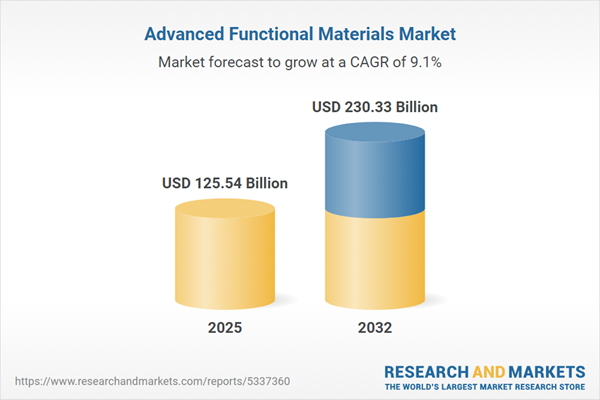Speak directly to the analyst to clarify any post sales queries you may have.
The advanced functional materials market is rapidly evolving, driven by rising demand for innovative, high-performance solutions across diverse industrial sectors. Businesses are adapting to new trends and competitive pressures in a landscape shaped by technology convergence and regulatory change.
Market Snapshot: Advanced Functional Materials Market
The Advanced Functional Materials Market grew from USD 115.09 billion in 2024 to USD 125.54 billion in 2025 and is expected to continue expanding at a CAGR of 9.06%, reaching USD 230.33 billion by 2032. This market’s momentum is underpinned by strong adoption in aerospace, automotive, renewable energy, electronics, and healthcare. Companies are advancing lightweight, durable, and multifunctional materials to meet escalating industry needs. The interplay between nanotechnology, sustainability standards, and global supply chains shapes leadership dynamics and growth trajectories for stakeholders throughout the value chain.
Scope & Segmentation
This report provides an in-depth analysis of the advanced functional materials market across material types, end-use industries, technology platforms, form factors, and regional markets. The following are core areas of coverage:
- Material Types: Ceramics (non-oxide, oxide); Composites (fiber reinforced, particulate); Metals (alloys, pure metals); Polymers (thermoplastic, thermoset)
- Application Areas: Aerospace and defense (avionics, structural components); Automotive and transportation (electric vehicles, safety systems); Electronics and electrical (actuators, semiconductors, sensors); Energy storage and generation (batteries, fuel cells, solar cells); Environmental (air purification, water treatment); Healthcare (drug delivery, medical devices)
- Technologies: Biomaterials (bioceramics, biopolymers); Conductive polymers (polyaniline, polythiophene); Nanomaterials (carbon nanotubes, graphene, quantum dots); Photonic materials (lasers, optical fibers); Smart materials (piezoelectrics, shape memory alloys, thermochromic materials)
- Form Factors: Bulk solids (blocks, pellets); Coatings (dip, spray); Fibers (carbon, glass); Films and sheets (flexible, rigid); Powders (micro, nano)
- Regional Coverage: Americas (United States, Canada, Mexico, Brazil, Argentina, Chile, Colombia, Peru); Europe, Middle East, Africa (United Kingdom, Germany, France, Russia, Italy, Spain, Netherlands, Sweden, Poland, Switzerland, UAE, Saudi Arabia, Qatar, Turkey, Israel, South Africa, Nigeria, Egypt, Kenya); Asia-Pacific (China, India, Japan, Australia, South Korea, Indonesia, Thailand, Malaysia, Singapore, Taiwan)
Leading providers analyzed include 3M Company, BASF SE, Dow Inc., DuPont de Nemours, Inc., Evonik Industries AG, Solvay S.A., Eastman Chemical Company, Arkema S.A., Cabot Corporation, and Wacker Chemie AG.
Key Takeaways for Senior Decision-Makers
- The market is characterized by accelerated technology convergence, especially through integration of nanotechnology, additive manufacturing, and collaborative research frameworks.
- End-user priorities are shifting toward sustainability and lifecycle optimization, prompting companies to invest in green materials and circular economy strategies.
- Competitive advantage often relies on robust intellectual property, partnerships, and digital material design platforms, enabling customized solutions for evolving application needs.
- Regional differences, shaped by local regulations, resource endowment, and industrial priorities, significantly influence adoption patterns and supply chain structures.
- Investments in supply chain localization and risk diversification are rising, helping organizations adapt to new cost pressures and logistical requirements.
Tariff Impact: 2025 Supply Chain and Cost Structures
Recent tariff policies in the United States have raised import duties on materials such as ceramic powders, metal alloys, and specialty polymers. This shift has prompted manufacturers to reassess sourcing strategies, renegotiate supplier contracts, and prioritize domestic or alternative supply chains. Aerospace, automotive, and research-focused industries are responding by investing in local processing, vertical integration, and new fabrication facilities to manage elevated costs and maintain competitive margins.
Methodology & Data Sources
This analysis integrates primary research—including executive interviews with top material suppliers, equipment manufacturers, and technology developers—with secondary review of academic sources, patents, regulatory filings, and industry presentations. Rigorous data triangulation, expert panel validation, and competitive benchmarking ensure accuracy and actionable insights for each market segment and region analyzed.
Why This Report Matters
- Enables executives to make informed strategic decisions by revealing the latest material innovations and application opportunities within the advanced functional materials market.
- Provides clear frameworks for supply chain resilience, risk mitigation, and sustainability integration relevant to multi-national manufacturers.
- Delivers a competitive benchmarking tool for evaluating providers by technology leadership, partnership strength, and digital transformation readiness.
Conclusion
The advanced functional materials market is evolving swiftly, shaped by cross-industry innovation, regional policy shifts, and new sustainability imperatives. Success depends on strategic agility, collaborative innovation, and a clear grasp of supply chain risks. This report equips stakeholders with the detailed market intelligence necessary to capture growth and manage transformation, supporting confident, future-ready decision-making.
Additional Product Information:
- Purchase of this report includes 1 year online access with quarterly updates.
- This report can be updated on request. Please contact our Customer Experience team using the Ask a Question widget on our website.
Table of Contents
3. Executive Summary
4. Market Overview
7. Cumulative Impact of Artificial Intelligence 2025
Companies Mentioned
The companies profiled in this Advanced Functional Materials market report include:- 3M Company
- BASF SE
- Dow Inc.
- DuPont de Nemours, Inc.
- Evonik Industries AG
- Solvay S.A.
- Eastman Chemical Company
- Arkema S.A.
- Cabot Corporation
- Wacker Chemie AG
Table Information
| Report Attribute | Details |
|---|---|
| No. of Pages | 193 |
| Published | November 2025 |
| Forecast Period | 2025 - 2032 |
| Estimated Market Value ( USD | $ 125.54 Billion |
| Forecasted Market Value ( USD | $ 230.33 Billion |
| Compound Annual Growth Rate | 9.0% |
| Regions Covered | Global |
| No. of Companies Mentioned | 11 |









